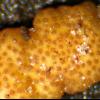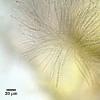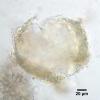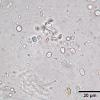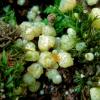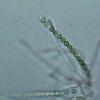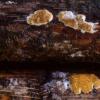
23-07-2010 21:59
 Christian Lechat
Christian Lechat
Dear friends, you can consult the document about

23-07-2010 14:33
Quijada LuisDears researchers, I will try to get a series of p

22-07-2010 23:59
 Martin Bemmann
Martin Bemmann
Dear all, since some days I enjoy scanning a pi

20-07-2010 14:30
Hi to all: I need your help about this small (up

19-07-2010 15:50
Gernot FriebesHi again, here I have the second collection and

19-07-2010 15:39
Gernot FriebesHi, Leptosphaeria is a really complicated genus
Aquatic Hypocrea
Martin Bemmann,
25-07-2010 19:28
 Dear all,
Dear all,today I collected some Hypocreas from a large decorticated branch of a broadleave tree lying in a small creek with clear freshwater. The part bearing the ascocarps was submerged and the ascocarps on the underside.
The surface of the stromata (ca. 1,5 mm dm.) is dark yellow to orange. The structure is gelatinous.
The inner diameter of the perithecia ic ca. 120 µm.
Asci measure 75,4-103,9 x 5-6,5 µm and some free spores 4,6-5,9 x 3,7-4,2 µm. The distale ones are globose in shape.
Is there a possibility to narrow down the determination by means of appearence and ecology?
Best regards,
Martin
Stip Helleman,
25-07-2010 22:27

Re:Aquatic Hypocrea
Hi Martin,
it looks very much like Hypocrea aureoviridis, the ascospores turn green. But there are more species, here is the literature link.
http://www.cbs.knaw.nl/publications/CBSPublicationDetails.aspx?Rec=1048
Gruss Stip
it looks very much like Hypocrea aureoviridis, the ascospores turn green. But there are more species, here is the literature link.
http://www.cbs.knaw.nl/publications/CBSPublicationDetails.aspx?Rec=1048
Gruss Stip
Martin Bemmann,
25-07-2010 22:57

Re:Aquatic Hypocrea
Hi Stip,
Thank yo for your suggestion!
I consulted this article before as well as Jaklitsch's recent one on the green spored ( http://www.cbs.knaw.nl/publications/CBSPublicationDetails.aspx?Rec=1063 ). The first is keying out the species very much based on culture features, I can't follow (actually it starts with such features). Now after your posting I read Jaklitsch's description of H. aureoviridis and I can't truely recognise my collection. For instance the ecology: "Habitat: on strongly decayed, crumbly wood of deciduous trees,often green from algae." does not fit. The branch was decorticatet but not rotten at all. I had problems to cut some specimen with my knife from the surface. And no mentioning of submerse growing. But ...
I was asking myself, is it a green spored one? And tried my best to make true colour pictures (did not work very good). To my impression the spores were hyaline and not green as those i found with this H.cf. gelatinosa (found September 2009 close to my recent collection) I'm showing below.
Best regards,
Martin
Thank yo for your suggestion!
I consulted this article before as well as Jaklitsch's recent one on the green spored ( http://www.cbs.knaw.nl/publications/CBSPublicationDetails.aspx?Rec=1063 ). The first is keying out the species very much based on culture features, I can't follow (actually it starts with such features). Now after your posting I read Jaklitsch's description of H. aureoviridis and I can't truely recognise my collection. For instance the ecology: "Habitat: on strongly decayed, crumbly wood of deciduous trees,often green from algae." does not fit. The branch was decorticatet but not rotten at all. I had problems to cut some specimen with my knife from the surface. And no mentioning of submerse growing. But ...
I was asking myself, is it a green spored one? And tried my best to make true colour pictures (did not work very good). To my impression the spores were hyaline and not green as those i found with this H.cf. gelatinosa (found September 2009 close to my recent collection) I'm showing below.
Best regards,
Martin
Stip Helleman,
26-07-2010 02:45

Re:Aquatic Hypocrea
hallo Martin,
as you know the spores are hyaline at first (in H. gelatinosa as well), i suggest you keep it alive for a few days becouse when i see your cross section of the stroma you see a light colouratian takes place already in the asci. But submerse growing is strange and that is also the reason why the wood is so hard, normally i would say aureoviridis grows preferrably on Salix which grows in wet places what is good for algae growth but i never found the wood so much rotten.
cheers Stip
as you know the spores are hyaline at first (in H. gelatinosa as well), i suggest you keep it alive for a few days becouse when i see your cross section of the stroma you see a light colouratian takes place already in the asci. But submerse growing is strange and that is also the reason why the wood is so hard, normally i would say aureoviridis grows preferrably on Salix which grows in wet places what is good for algae growth but i never found the wood so much rotten.
cheers Stip
Thierry Duchemin,
26-07-2010 09:55
Re:Aquatic Hypocrea
Bonjour Martin et stip,
J'ai une récolte faite par Maurice Gérard à l'étang de Juvigné (53),sur phragmites le 05/04/2002.(cf.photo.)
La macro et micro correspondent à ta récolte. J'avais envoyé une partie du matériel à Christian le 21/10/2003,mais cette partie s'est révélée immature,c'est donc resté sans nom.
Bien cordialement,
Thierry.
J'ai une récolte faite par Maurice Gérard à l'étang de Juvigné (53),sur phragmites le 05/04/2002.(cf.photo.)
La macro et micro correspondent à ta récolte. J'avais envoyé une partie du matériel à Christian le 21/10/2003,mais cette partie s'est révélée immature,c'est donc resté sans nom.
Bien cordialement,
Thierry.
Martin Bemmann,
26-07-2010 20:23

Re:Aquatic Hypocrea
Hi Stip and Thierry,
@ Stip: Ok, I will try to keep them alive as long as possible. Your suggestion of aureoviridis is promising. I don't know what happened with this branch before I found it. There are plenty of boars active along this creek, maybe it was turned.
@ Thiery: Thank you for sharing your matching collecion! Your stromata look somewhat different by shape but similar by colour. I have definitely not enough experience to have a valid oppinion.
Thanks a lot and
Best regards,
Martin
@ Stip: Ok, I will try to keep them alive as long as possible. Your suggestion of aureoviridis is promising. I don't know what happened with this branch before I found it. There are plenty of boars active along this creek, maybe it was turned.
@ Thiery: Thank you for sharing your matching collecion! Your stromata look somewhat different by shape but similar by colour. I have definitely not enough experience to have a valid oppinion.
Thanks a lot and
Best regards,
Martin
Gary Samuels,
27-07-2010 14:42
Re:Aquatic Hypocrea
A sad reality is that stromata of distinct,even only distantly related Hypocrea species can be indistinguishable. Knowing the anamorph can be helpful in identifying these species. So, based on the information presented by Martin, and using Jaklitsch's fine treatment of European green-spored Hypocrea (and Chaverri & Samuels more comprehensive treatment of green-spored Hypocrea), I am giuessing that this is H. sinuosa. I don't think it's H gelatinosa because in that species the perithecia are more protuberant (the stromata appear to be tuberculate). Hypocrea aureoviridis has larger stromata with more numerous perithecia; it has a more northern distribution (Netherlands, England and Atlantic coast of France according to Jaklitsch). I doubt that this is an aquatic species; most likely it is only in the water as a result of bad luck.
Martin Bemmann,
27-07-2010 19:22

Re:Aquatic Hypocrea
Thank you very much for your comment!
I can follow pretty good your determination by reading Jaklitsch's key backwards from sinuosa.
We had a long dry period here followed by some days of rain (after that I found this collection). There is a good chance that the stromata grew during the dry period and were submersed due to an increasing water level after the rain.
Thank you again and my best regards,
Martin
I can follow pretty good your determination by reading Jaklitsch's key backwards from sinuosa.
We had a long dry period here followed by some days of rain (after that I found this collection). There is a good chance that the stromata grew during the dry period and were submersed due to an increasing water level after the rain.
Thank you again and my best regards,
Martin
Gary Samuels,
27-07-2010 19:43
Re:Aquatic Hypocrea
Thierry's collection is something else. Most likely it has hyaline ascospores. It looks a bit like H. patella and H. pseudostraminea. Walter Jaklitsch is continuing to work on Hypocrea for Europe; eventually you will have his complete work to help you identify these fungi.
Gary Samuels,
27-07-2010 19:43
Re:Aquatic Hypocrea
Thierry's collection is something else. Most likely it has hyaline ascospores. It looks a bit like H. patella and H. pseudostraminea. Walter Jaklitsch is continuing to work on Hypocrea for Europe; eventually you will have his complete work to help you identify these fungi.
Thierry Duchemin,
28-07-2010 14:00
Re:Aquatic Hypocrea
Hello all,
Thanks Gary for your precise infos, i'll search this way.
Best Regards,
Thierry.
Thanks Gary for your precise infos, i'll search this way.
Best Regards,
Thierry.

